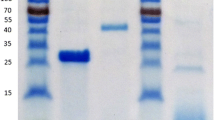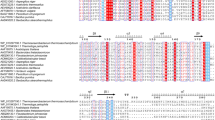Abstract
A novel exo-arabinase (GH93, exo-ABN) enzyme produced by the ascomycete Penicillium canescens has been studied. Cloning of the abn1 gene coding for exo-ABN into the recipient P. canescens strain RN3-11-7 yielded recombinant producing strains characterized by a high yield of extracellular exo- ABN production (20–30% of the total amount of extracellular protein). Chromatographic purification yielded a homogenous exo-ABN with a molecular weight of 47 kDa, as shown by SDS-PAGE. The enzyme showed high specific activity towards linear arabinan (117 U/mg) and low specific activity towards branched arabinan and arabinoxylan (4–5 U/mg) and para-nitrophenyl-α-L-arabinofuranoside (0.3 U/mg), whereas arabinogalactan and para-nitrophenyl-α-L-arabinopyranoside, the substrates that contained the pyranose form of arabinose, were not hydrolyzed. Arabinohexaose was the major product of linear arabinan hydrolysis. Exo-ABN had a pH optimum at 5.0 and a temperature optimum at 60°C. The enzyme was stable in a broad pH range (4.0–7.0) and upon heating to 50°C during 180 min. Extensive hydrolysis of linear and branched arabinans by exo- and endo-arabinase mixtures, arabinofuranosidase, and arabinofuran-arabinoxylan hydrolase has been performed. The degree of substrate conversion amounted to 67 and 83% of the maximal possible value, respectively.
Similar content being viewed by others
References
Sakamoto, T. and Thibault, J.F., Appl. Environ. Microbiol., 2001, vol. 67, pp. 3319–3321.
Proctor, M.R., Taylor, E.J., Nurizzo, D., Turkenburg, J.P., Lloyd, R.M., Vardakou, M., Davies, G.J., and Gilbert, H.J., Proc. Natl. Acad. Sci. U.S.A., 2005, vol. 102, pp. 2697–2702.
McKie, V.A., Black, G.W., and Willward-Sadler, S.J., Biochem. J., 1997, vol. 323, pp. 547–555.
Wong, D.W.S., Chan, V.J., and Batt, S.B., Appl. Microbiol. Biotechnol., 2008, vol. 79, pp. 941–950.
Kuhnel, S., Hinz, S.W.A., Pouvreau, L., Wery, J., Schools, H.A., and Gruppen, H., Biores. Technol., 2010, vol. 101, pp. 8300–8307.
Kaji, A. and Shimokawa, K., Agric. Biol. Chem., 1984, vol. 48, pp. 67–72.
Whitaker, J.R., Voragen, A.G., and Wong, D.W.S., Handbook of Food Enzymology, New York; Basel: Marcel Dekker, 2003.
Hemicellulose and Hemicellulases, Coughlan, M.P. and Hazlewood, G.P., Eds., London and Chapel Hill: Portland Press Research Monograph, 1993.
Rubtsova, E.A., Bushina, E.V., Rozhkova, A.M., Korotkova, O.G., Nemashkalov, V.A., Koshelev, A.V., and Sinitsyn, A.P., Appl. Biochem. Microbiol., 2015, vol. 51, no. 5, pp. 591–599.
Matys, V.Yu., Bubnova, T.V., Koshelev, A.V., Vel’kov, V.V., Okunev, O.N., Bravova, G.B., Shishkova, E.A., Semenova, M.V., and Sinitsyn, A.P., in Mikrobnye biokatalizatory i perspektivy razvitiya fermentnykh tekhnologii v pererabatyvayushchikh otraslyakh APK (Microbial Biocatalysts and Prospects for the Development of Enzyme Technologies in the Processing Industries of the Agro-Industrial Complex), Moscow: Pishchepromizdat, 2004.
Sinitsyna, O.A., Bukhtoyarov, F.E., Gusakov, A.V., Okunev, O.N., Bekkarevich, A.O., Vinetskii, Yu.P., and Sinitsyn, A.P., Biochemistry (Moscow), 2003, vol. 68, no. 11, pp. 1200–1209.
Sinitsyn, A.P. and Rozhkova, A.M., Penicillium canescens Host as a Platform for Development of a New Recombinant Strain Producers of Carbohydrases, Microbiology Monographs, Berlin, Heidelberg: Springer-Verlag, 2015.
Sanger, F., Nicklen, S., and Chase, A.R., Proc. Natl. Acid. Sci. U.S.A., 1977, vol. 74, no. 12, pp. 5463–5467.
Aleksenko, A., Makarova, N., Nikolaev, I., and Clutterbuck, A., Curr. Genet., 1995, vol. 28, pp. 474–478.
Sinitsyn, A.P., Chernoglazov, V.M., and Gusakov, A.V., Metody izucheniya i svoistva tsellyuloliticheskikh fermentov (Methods of Study and Properties of Cellulolytic Enzymes), Itogi nauki i tekhniki, Ser. Biotekhnol., Moscow: VINITI, 1990, vol. 25, p. 148.
Author information
Authors and Affiliations
Corresponding author
Additional information
Original Russian Text © M.V. Semenova, P.V. Volkov, A.M. Rozhkova, I.N. Zorov, A.P. Sinitsyn, 2018, published in Prikladnaya Biokhimiya i Mikrobiologiya, 2018, Vol. 54, No. 4.
Rights and permissions
About this article
Cite this article
Semenova, M.V., Volkov, P.V., Rozhkova, A.M. et al. Cloning, Isolation, and Properties of a New Homologous Exoarabinase from the Penicillium canescens Fungus. Appl Biochem Microbiol 54, 387–395 (2018). https://doi.org/10.1134/S0003683818040130
Received:
Published:
Issue Date:
DOI: https://doi.org/10.1134/S0003683818040130




